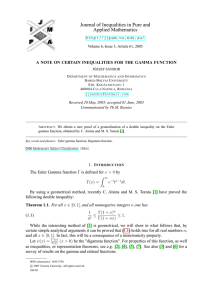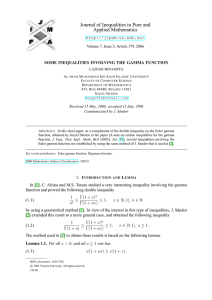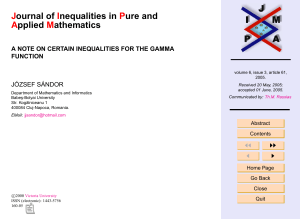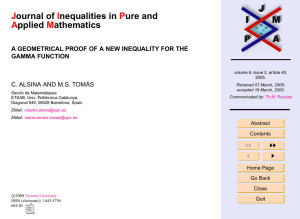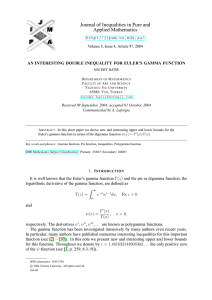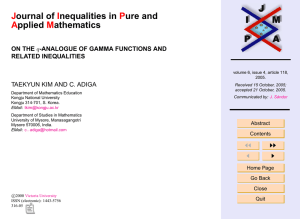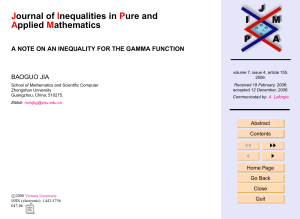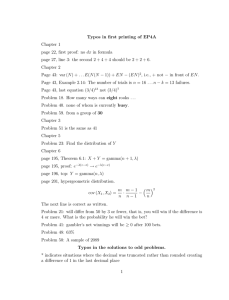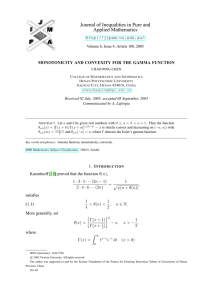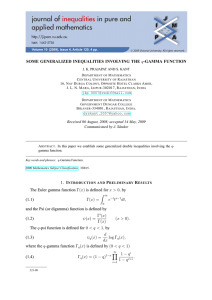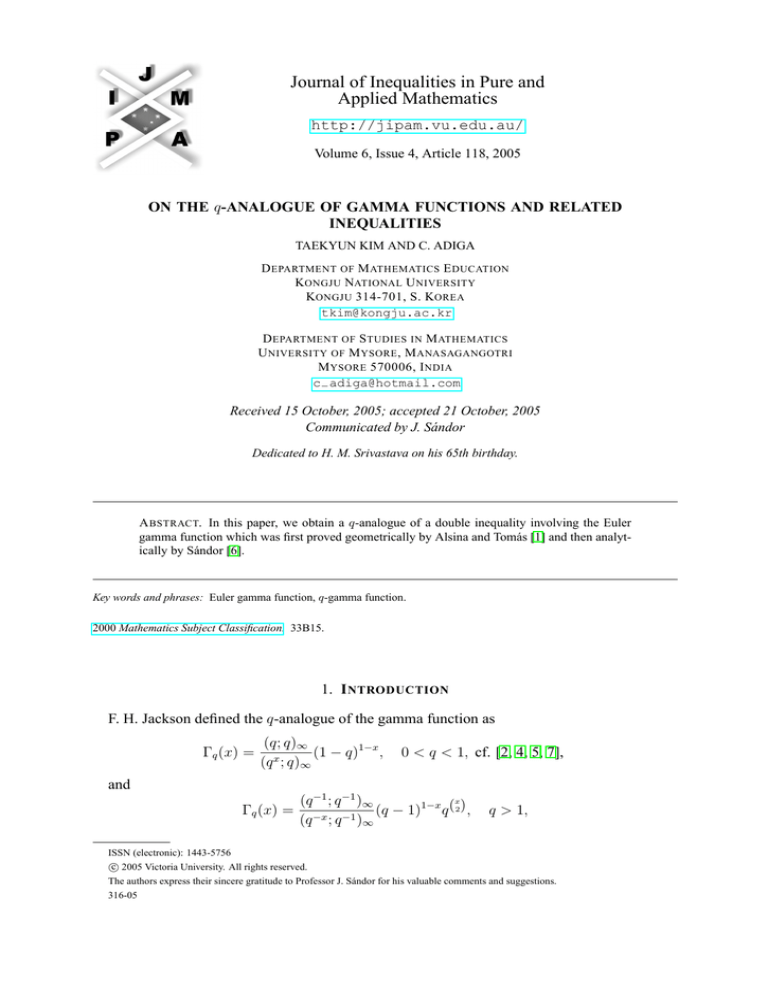
Journal of Inequalities in Pure and
Applied Mathematics
http://jipam.vu.edu.au/
Volume 6, Issue 4, Article 118, 2005
ON THE q-ANALOGUE OF GAMMA FUNCTIONS AND RELATED
INEQUALITIES
TAEKYUN KIM AND C. ADIGA
D EPARTMENT OF M ATHEMATICS E DUCATION
KONGJU NATIONAL U NIVERSITY
KONGJU 314-701, S. KOREA
tkim@kongju.ac.kr
D EPARTMENT OF S TUDIES IN M ATHEMATICS
U NIVERSITY OF M YSORE , M ANASAGANGOTRI
M YSORE 570006, I NDIA
c− adiga@hotmail.com
Received 15 October, 2005; accepted 21 October, 2005
Communicated by J. Sándor
Dedicated to H. M. Srivastava on his 65th birthday.
A BSTRACT. In this paper, we obtain a q-analogue of a double inequality involving the Euler
gamma function which was first proved geometrically by Alsina and Tomás [1] and then analytically by Sándor [6].
Key words and phrases: Euler gamma function, q-gamma function.
2000 Mathematics Subject Classification. 33B15.
1. I NTRODUCTION
F. H. Jackson defined the q-analogue of the gamma function as
Γq (x) =
(q; q)∞
(1 − q)1−x ,
x
(q ; q)∞
0 < q < 1, cf. [2, 4, 5, 7],
and
Γq (x) =
x
(q −1 ; q −1 )∞
(q − 1)1−x q (2) ,
−x
−1
(q ; q )∞
q > 1,
ISSN (electronic): 1443-5756
c 2005 Victoria University. All rights reserved.
The authors express their sincere gratitude to Professor J. Sándor for his valuable comments and suggestions.
316-05
2
TAEKYUN K IM AND C. A DIGA
where
(a; q)∞ =
∞
Y
(1 − aq n ).
n=0
It is well known that Γq (x) → Γ(x) as q → 1− , where Γ(x) is the ordinary Euler gamma
function defined by
Z ∞
Γ(x) =
e−t tx−1 dt, x > 0.
0
Recently Alsina and Tomás [1] have proved the following double inequality on employing a
geometrical method:
Theorem 1.1. For all x ∈ [0, 1], and for all nonnegative integers n, one has
1
Γ(1 + x)n
(1.1)
≤
≤ 1.
n!
Γ(1 + nx)
Sándor [6] has obtained a generalization of (1.1) by using certain simple analytical arguments. In fact, he proved that for all real numbers a ≥ 1, and all x ∈ [0, 1],
1
Γ(1 + x)a
(1.2)
≤
≤ 1.
Γ(1 + a)
Γ(1 + ax)
But to prove (1.2), Sándor used the following result:
Theorem 1.2. For all x > 0,
(1.3)
∞
X
Γ0 (x)
1
= −γ + (x − 1)
.
Γ(x)
(k
+
1)(x
+
k)
k=0
In an e-mail message, Professor Sándor has informed the authors that, relation (1.2) follows
also from the log-convexity of the Gamma function (i.e. in fact, the monotonous increasing
property of the ψ -function). However, (1.3) implies many other facts in the theory of gamma
functions. For example, the function ψ(x) is strictly increasing for x > 0, having as a consequence that, inequality (1.2) holds true with strict inequality (in both sides) for a > 1. The main
purpose of this paper is to obtain a q-analogue of (1.2). Our proof is simple and straightforward.
2. M AIN R ESULT
In this section, we prove our main result.
Theorem 2.1. If 0 < q < 1, a ≥ 1 and x ∈ [0, 1], then
1
Γq (1 + x)a
≤
≤ 1.
Γq (1 + a)
Γq (1 + ax)
Proof. We have
(2.1)
Γq (1 + x) =
(q; q)∞
(1 − q)−x
(q 1+x ; q)∞
and
(2.2)
Γq (1 + ax) =
J. Inequal. Pure and Appl. Math., 6(4) Art. 118, 2005
(q; q)∞
(1
1+ax
(q
; q)∞
− q)−ax .
http://jipam.vu.edu.au/
O N THE q-A NALOGUE OF G AMMA F UNCTIONS AND R ELATED I NEQUALITIES
3
Taking the logarithmic derivatives of (2.1) and (2.2), we obtain
∞
X
d
q 1+x+n
(2.3)
(log Γq (1 + x)) = − log(1 − q) + log q
, cf. [3, 4, 5],
1+x+n
dx
1
−
q
n=0
and
(2.4)
∞
X
q 1+ax+n
d
(log Γq (1 + ax)) = −a log(1 − q) + a log q
.
1+ax+n
dx
1
−
q
n=0
Since x ≥ 0, a ≥ 1, log q < 0 and
q 1+x+n
q 1+ax+n − q 1+x+n
q 1+ax+n
−
=
≤ 0,
1 − q 1+ax+n 1 − q 1+x+n
(1 − q 1+ax+n )(1 − q 1+x+n )
we have
(2.5)
d
d
(log Γq (1 + ax)) ≥ a (log Γq (1 + x)) .
dx
dx
Let
g(x) = log
Γq (1 + x)a
,
Γq (1 + ax)
a ≥ 1, x ≥ 0.
Then
g(x) = a log Γq (1 + x) − log Γq (1 + ax)
and
d
d
(log Γq (1 + x)) −
(log Γq (1 + ax)) .
dx
dx
By (2.5), we get g 0 (x) ≤ 0, so g is decreasing. Hence the function
g 0 (x) = a
f (x) =
Γq (1 + x)a
,
Γq (1 + ax)
a≥1
is a decreasing function of x ≥ 0. Thus for x ∈ [0, 1] and a ≥ 1, we have
Γq (2)a
Γq (1 + x)a
Γq (1)a
≤
≤
.
Γq (1 + a)
Γq (1 + ax)
Γq (1)
We complete the proof by noting that Γq (1) = Γq (2) = 1.
Remark 2.2. Letting q to 1 in the above theorem. we obtain (1.2).
Remark 2.3. Letting q to 1 and then putting a = n in the above theorem, we get (1.1).
R EFERENCES
[1] C. ALSINA AND M.S. TOMÁS, A geometrical proof of a new inequality for the gamma function, J.
Inequal. Pure and Appl. Math., 6(2) (2005), Art. 48. [ONLINE http://jipam.vu.edu.au/
article.php?sid=517].
[2] T. KIM AND S.H. RIM, A note on the q-integral and q-series, Advanced Stud. Contemp. Math., 2
(2000), 37–45.
[3] T. KIM, q-Volkenborn Integration, Russian J. Math. Phys., 9(3) (2002), 288–299.
[4] T. KIM, On a q-analogue of the p-adic log gamma functions and related integrals, J. Number Theory,
76 (1999), 320–329.
[5] T. KIM, A note on the q-multiple zeta functions, Advan. Stud. Contemp. Math., 8 (2004), 111–113.
J. Inequal. Pure and Appl. Math., 6(4) Art. 118, 2005
http://jipam.vu.edu.au/
4
TAEKYUN K IM AND C. A DIGA
[6] J. SÁNDOR, A note on certain inequalities for the gamma function, J. Inequal. Pure and Appl.
Math., 6(3) (2005), Art. 61. [ONLINE http://jipam.vu.edu.au/article.php?sid=
534].
[7] H. M. SRIVASTAVA, T. KIM AND Y. SIMSEK, q-Bernoulli numbers and polynomials associated
with multiple q-zeta functions and basic L-series , Russian J. Math. Phys., 12 (2005), 241–268.
J. Inequal. Pure and Appl. Math., 6(4) Art. 118, 2005
http://jipam.vu.edu.au/

